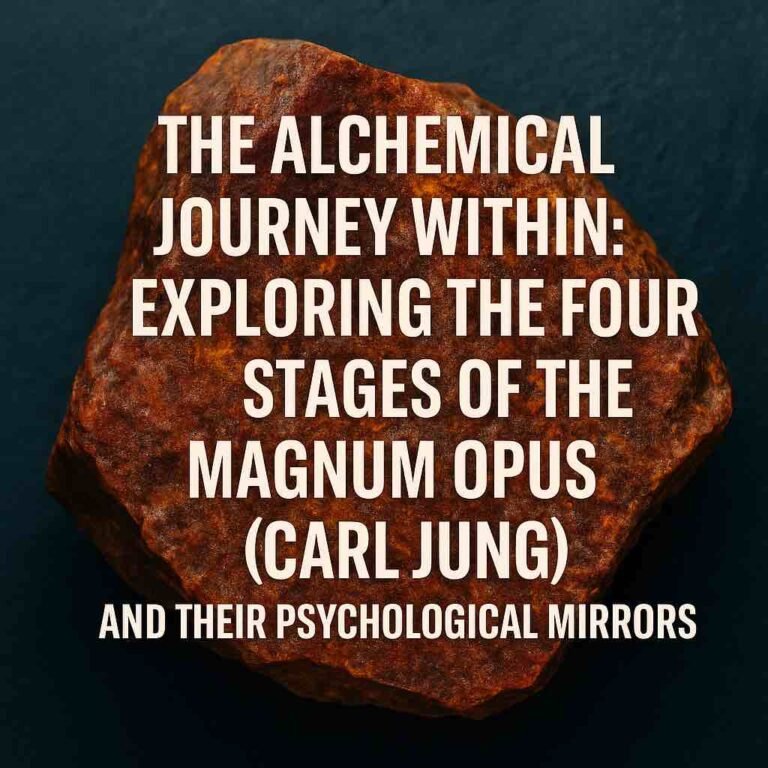In Ancient times, in the shadowy laboratories of medieval alchemists, the Magnum Opus, or “Great Work”, wasn’t just about turning lead into gold. It was a profound metaphor for inner transformation, a symbolic roadmap for elevating the human spirit from base matter to divine essence.
This ancient process, divided into four distinct stages (Nigredo, Albedo, Citrinitas, and Rubedo) has captivated philosophers, mystics, and psychologists for centuries. Carl Gustav Jung, the Swiss psychiatrist and founder of analytical psychology, saw in these alchemical stages a blueprint for the psyche’s evolution. He interpreted them as psychological processes: Confession, Illumination, Education, and Transformation.
Jung believed that alchemy was less about literal chemistry and more about the unconscious mind’s quest for wholeness, or individuation. The alchemists, in their pursuit of the Philosopher’s Stone, were unwittingly projecting their inner psychic dramas onto their experiments.
Today, these stages offer timeless insights into personal growth, therapy, and self-discovery. In this in-depth exploration, we’ll study and reveal each stage, unpacking its alchemical origins, symbolic meanings, and Jungian psychological parallels.
We’ll examine historical contexts, mythical resonances, and practical applications for modern life. And finally, we’ll connect this ancient wisdom to a contemporary coaching framework, showing how timeless truths evolve in new forms.
Nigredo: The Blackening – Confession and the Descent into Shadow
The first stage of the Magnum Opus, Nigredo, translates to “blackening” or “putrefaction.” In alchemical texts, this is depicted as the initial breakdown of the prima materia, the raw, base substance from which all transformation begins. Alchemists would heat, dissolve, and decompose their materials in a sealed vessel, watching as everything turned to a foul, blackened mass.
This was no mere chemical reaction; it symbolized death, decay, and the confrontation with chaos.
Historically, Nigredo draws from ancient Egyptian and Greek traditions, where black was associated with the fertile soil of the Nile or the primordial void from which creation emerges. In medieval grimoires like the Turba Philosophorum, it’s described as a time of mortification, where the “body” (matter) is killed to release the “spirit.”
Symbolically, this stage is ruled by Saturn, the planet of limitation and melancholy, often illustrated with ravens, skulls, or eclipses, images of eclipse and dissolution.
Jung interpreted Nigredo as the psychological phase of Confession. This is the unflinching admission of one’s inner darkness, the confrontation with the Shadow, the repressed, unconscious aspects of the self that we hide from the world and ourselves. In Jungian terms, the Shadow encompasses our instincts, fears, traumas, and unacknowledged desires.
Entering Nigredo means descending into the underworld of the psyche, much like Orpheus or Dante’s Inferno.
Psychologically, this stage manifests as a crisis: depression, anxiety, or a midlife unraveling where old structures crumble. Think of it as the “dark night of the soul” described by mystics like St. John of the Cross. Confession here isn’t just verbal admission; it’s a visceral process of owning one’s flaws. Jung wrote in Psychology and Alchemy that this is where the ego faces annihilation, allowing the unconscious to flood in.
Without this breakdown, no rebirth is possible, it’s the compost from which growth sprouts.
In practical terms, Nigredo might appear in therapy as the initial sessions where a client “confesses” buried secrets: addictions, betrayals, or unresolved grief. It’s the moment an executive admits burnout, or an artist confronts creative blocks rooted in self-doubt.
Mythically, it’s mirrored in stories like Persephone’s abduction to Hades, where winter’s barrenness precedes spring’s renewal.
But Nigredo isn’t endless despair, it’s purposeful. Alchemists knew that beneath the rot lay hidden potential, the “black sun” (sol niger) that holds the seed of light.
Jung emphasized that confessing the Shadow integrates it, preventing it from sabotaging us unconsciously. This stage teaches humility and resilience, reminding us that true transformation begins in vulnerability.
As we emerge from Nigredo’s depths, the alchemical vessel begins to lighten, setting the stage for purification.
Albedo: The Whitening – Illumination and the Dawn of Clarity
Following the chaos of Nigredo comes Albedo, the “whitening” or “purification” phase.
In the laboratory, this involved washing away the blackened impurities through distillation or sublimation, resulting in a silvery-white substance. Alchemists associated this with the moon’s gentle light, mercury’s fluidity, and the element of water—symbols of cleansing and reflection.
Rooted in Hermetic traditions, Albedo is often depicted in illuminated manuscripts as a dove descending or a king and queen uniting in a bath. It’s the alchemical “lesser work,” preparing for greater unions ahead. Influenced by Arabic alchemists like Jabir ibn Hayyan, this stage emphasizes separation and refinement, distilling essence from dross.
Jung linked Albedo to Illumination, the psychological awakening where consciousness expands. After confessing the Shadow in Nigredo, the psyche begins to integrate opposites: masculine and feminine, conscious and unconscious. This is the birth of the anima (feminine soul in men) or animus (masculine spirit in women), leading to inner harmony.
Illumination feels like a revelation, a “eureka” moment where patterns clarify. In Jung’s view, it’s the alchemical “conjunctio oppositorum,” the sacred marriage that resolves inner conflicts. Dreams during this phase might feature luminous symbols: pearls, dawn skies, or guiding figures.
Psychologically, it’s akin to the “aha” in cognitive therapy, where repressed emotions surface as insights, fostering self-awareness.In everyday life, Albedo manifests as post-crisis clarity: after a breakup, one gains perspective on relational patterns; after job loss, new passions emerge. It’s the phase of mindfulness practices, journaling, or meditation that polish the mind like alchemists polished their metals.
Mythologically, Albedo echoes the resurrection motifs in Osiris’s story or Christ’s harrowing of hell, emerging purified from darkness. Jung saw it as the ego’s dialogue with the Self, the archetype of wholeness. Yet, illumination isn’t passive; it requires active reflection, like the alchemist’s vigilant stirring.
This whitening sets the foundation for deeper wisdom, transitioning to the golden hues of the next stage.
Citrinitas: The Yellowing – Education and the Ripening of Wisdom
Citrinitas, the “yellowing” or “citron-making,” is the third stage, often overlooked in simplified alchemical schemas but crucial in fuller traditions. Here, the white substance from Albedo takes on a golden-yellow tint, symbolizing the sun’s maturing influence.
Alchemists achieved this through further heating, evoking the ripening of fruit or the dawn’s transition to full daylight.
In historical texts like Paracelsus’s works, Citrinitas is tied to the element of air and the planet Jupiter, representing expansion and knowledge. It’s illustrated as a peacock’s tail (cauda pavonis), a burst of iridescent colors signaling multiplicity before unity. This stage bridges the lunar Albedo and solar Rubedo, emphasizing intellectual and spiritual maturation.
Jung described Citrinitas as Education, the psychological process of synthesizing insights into practical wisdom. Building on Illumination, this is where the individuating self learns to navigate the world with integrated knowledge. It’s the education of the soul, reconciling intellect and intuition, theory and practice.
In Jungian analysis, Education involves archetypes like the Wise Old Man or Woman, guiding the psyche toward maturity. It’s the stage of active learning: reading, therapy dialogues, or life experiences that “yellow” the personality with depth. Psychologically, it addresses the integration of the persona (social mask) with the true Self, fostering authenticity.
Practically, Citrinitas appears in educational pursuits post-illumination: enrolling in courses after a spiritual awakening, or applying therapeutic insights to relationships. It’s the “ripening” phase where initial epiphanies evolve into habits, like turning mindfulness into daily ethics.
Mythically, it’s akin to Prometheus stealing fire (gaining divine knowledge at a cost) or the Grail Quest’s trials that educate the knight. Jung noted that without this stage, transformation remains superficial; Education ensures insights endure.
As the yellow deepens to red, the Magnum Opus nears completion.
Rubedo: The Reddening – Transformation and the Union of Opposites
The final stage, Rubedo, means “reddening” or “incarnation.” In the alchemical flask, the yellow matter fuses into a vibrant red, birthing the Philosopher’s Stone, a panacea capable of transmuting base metals to gold and granting immortality. This is the “greater work,” symbolized by fire, the sun, and the phoenix rising from ashes.
Drawing from Rosicrucian and Renaissance alchemies, Rubedo is the ultimate conjunctio: the red king (sulfur) unites with the white queen (mercury) in eternal harmony. It’s depicted as a hermaphrodite or a red lion, embodying perfected unity.
Jung viewed Rubedo as Transformation, the culmination of individuation where the Self fully emerges. After Education, the psyche achieves wholeness, integrating all aspects into a transformed personality. This is the “ruby” of the soul, resilient, radiant, and capable of influencing the world.
Psychologically, Transformation manifests as profound change: a healed individual radiating authenticity, empathy, and purpose. Jung called it the “chymical wedding,” where opposites (conscious/unconscious, good/evil) merge, birthing the lapis philosophorum (philosopher’s stone), the individuated Self.
In life, Rubedo is the “new normal” after growth: a recovered addict mentoring others, or a leader embodying visionary change. It’s sustained by ongoing practices, ensuring the stone doesn’t tarnish.
Mythically, it’s the apotheosis in hero’s journeys, like Hercules’ ascension or Buddha’s enlightenment, eternal transformation.
Bridging Ancient Alchemy to Modern Coaching: The R.I.S.E Model
The four stages of the Magnum Opus offer a profound lens on human potential, but their wisdom isn’t confined to history. In contemporary coaching, models like Coach G’s RISE framework (Reveal, Integrate, Shift, Embody) echo these alchemical and Jungian processes, adapting them for practical self-mastery.
- Reveal mirrors Nigredo’s Confession: It’s the bold uncovering of hidden truths, facing shadows to spark change.
- Integrate aligns with Albedo’s Illumination: Here, insights are woven into the self, fostering clarity and balance.
- Shift parallels Citrinitas’s Education: This is the active learning and pivoting, ripening knowledge into action.
- Embody culminates like Rubedo’s Transformation: Fully living the change, incarnating wholeness in daily life.
By drawing on RISE, Coach G provides a streamlined path that honors alchemy’s depth while making it accessible. Whether in personal development or leadership coaching, this model transforms the esoteric into the everyday, proving that the Great Work lives on in us all. If you’re ready to alchemize your life, start with confession—and rise.






